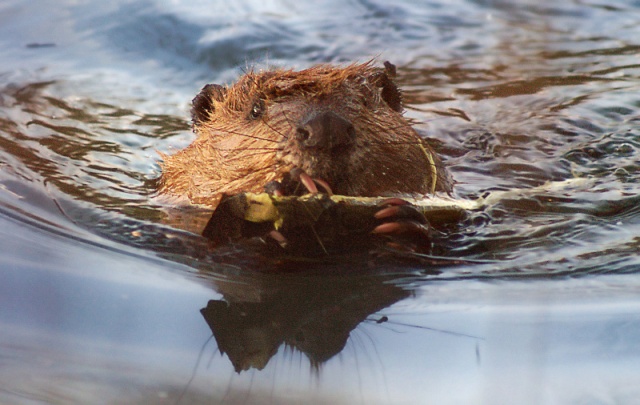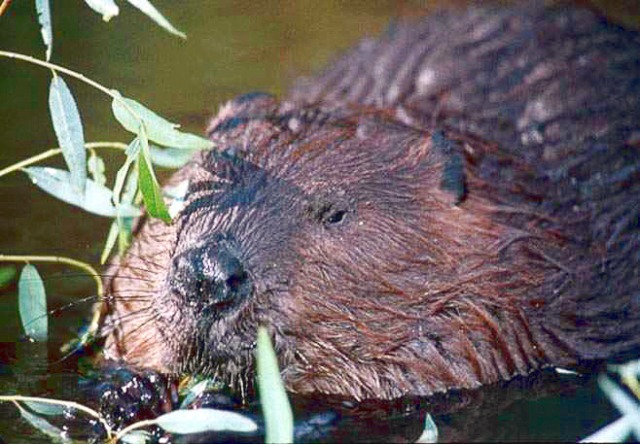Please excuse the pun – I could not help myself! 😀 This post is not about a troubled teenaged pop-star. Rather it is about a fascinating semi-aquatic rodent.
Beavers have been in the news quite a bit lately. I think it started when PBS Nature released an episode titled, Leave it to Beavers. The show aired the middle of last month and it has generated a flurry of discussion on the internet as well as some prominent media coverage.
If you have not seen it yet, here is a link to the full episode from PBS. The network sometimes takes videos off its site, so please let me know if the link stops working.

Beaver towing branch.
Photo courtesy of www.wpclipart.com
Controversial Animals
Beavers are controversial because their dam building activities can flood land occupied by humans. They can also divert water to places we would rather it not flow. But recent research signals that beavers play an important part in natural ecosystems. By keeping water on the land, they reduce the impact of drought. They also create habitat for a variety of creatures that require water to survive. As a result, some states like Utah are experimenting with reintroducing beaver. The west continues to experience severe drought and this has prompted some to reconsider the role beavers play in the environment.
Beavers were Everywhere
The latest news in my area is that a citizen science project has challenged the findings of the famous naturalist Joseph Grinnell (of Grinnell journaling). He thought that beavers were not native to California. But he did not have the benefit of digital records! It appears that beavers were wiped out by humans 75 to 100 years before Grinnell started looking for them. A father/son team used digital records to find compelling evidence that beavers were once widespread throughout California. They found accounts of beaver by the Spanish and by visiting sea captains. They found Native American cave paintings depicting beaver as well as accounts of beaver bones found in California middens. This jives with common sense that predicts beaver should have existed in many of California’s environments. Here is a link to the article. It makes an interesting story if you like beavers, citizen science, or natural history.
Beavers Used to Be Almost Everywhere in California

Beaver up close.
Photo courtesy of www.wpclipart.com
Hey, That Species Looks Familar
Whatever your feelings about the animal, beavers are undeniably fascinating. They modify their environment, build structures in which to live, control water, cache food, teach their children, and harvest timber. Sound like another species we know?… 😉
What do you think of beaver? Feel free to share your thoughts in the comments section, below.
You can also find more posts about our natural world in the nature section.


What do I think of the beaver? I think people should only care about beavers if they like fresh water, working wells, salmon and trout, migratory and songbirds, frogs, bats and other wildlife.
Otherwise they should keep trapping them at the current rate and never worry about what a valuable resource our state is throwing away every day.
Heidi Perryman
Worth A Dam
http://www.martinezbeavers.org
Thanks for the comment, Heidi!
As I researched this post, I was struck by how controversial the beaver has become in many parts of the country. Recent thinking suggests that beavers play an important role in creating and maintaining a healthy ecology. I suspect the biggest impediment to its reintroduction/preservation at this time is landowners’ fear that nearby beavers will flood their land. These fears will ultimately have to be addressed as part of any successful reintroduction/preservation plan. I am actually optimistic it can happen.
I have never seen a beaver in the wild. But one day I hope to do so. It would be nice if I do not have to travel very far to see one in its natural habitat.
– Steve
What we learned when we tried to save beavers in Martinez 8 years ago was that it was WAY easier to solve the problems than to change the minds!
Flow devices can protect culverts and lower dam height and they are inexpensive,effective tools that have been well understood for decades.
Our Castor Master has controlled pond height since 2008 and is still going strong.Meanwhile since the beavers are still there they can use their naturally territorial behaviors to keep others away. Remember young leave to find their own territory. We have had kits born every year since 2007 and our population is 7.
Any city or landowner can coexist with beaver. They just have to be slight smarter than a beaver.
Heidi
Worth A Dam